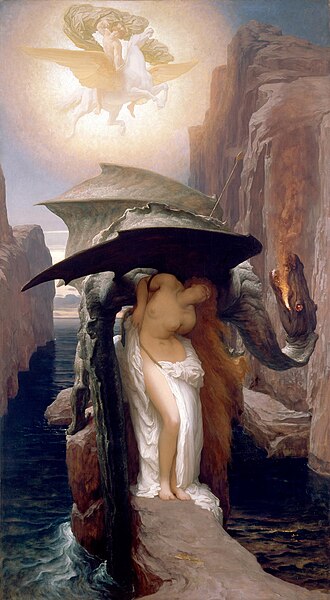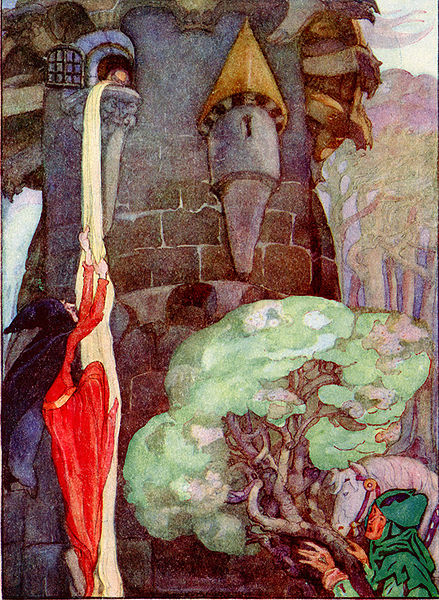 |
| Psyche being led to the mountainside, where she will be exposed to her demon lover. |
I have written of the “Damon Complex.” Perhaps, in the end, it is better to call it the “Dymphna complex”; for Saint Dymphna is the protagonist of the tale, and is far better known than her father. Now let me try to break it down into its essential elements. I believe it may tell us something important, as a superior substitute for the Oedipus Complex, about the true origins of much or all mental illness.
A: a parent (or other operating
in loco parentis) wishes to or tries to do a child harm. The common fairy tale motif of the “wicked step parent” may be introduced to soften the blow, or perhaps to convey the concept of a discrepancy between presumed love and actual hate: what is apparent is not real. The apparent parent is not a true parent.
In the Dymphna story, her father King Damon beheads her. That is, shall we say, pretty clear-cut. In the Oedipus story, his father tries to kill him twice, once by exposure as an infant, once at the crossroads. Oedipus's lack of knowledge of his own parents serves the same purpose as the “wicked step-parent” motif, inverting it: the apparent parents are not the real parents. That is, they do not act as parents are supposed to act.
B: a parent (or other operating
in loco parentis) wishes to or tries to own a child completely, denying them an independent life—the Rapunzel Complex. Theoretically, we should not expect to see this happening along with A in the same story, because the two are generally incompatible. But they are symptoms and products of the same root cause, a selfish parent who does not see the child as an independent soul with his or her own rights.
In the Dymphna story, her father King Damon demands marriage, then tracks her down when she flees—the ultimate helicopter parent.
In the Oedipus story, both mother and father seek to kill Oedipus; it is Jocasta who actually hands him over to be exposed. And it is Jocasta who mates with him. One might, fairly, argue that at least this latter is unintentional. On the other hand, Oedipus bears the scars of his laming by his parents. While he would know nothing about this, it is reasonable to expect Jocasta, seeing this scar, to at least have suspicions about his true identity. The Oedipus story manages the trick of having the same parent both seek to kill and seek to totally possess the same child.
 |
| The Judgement of Solomon: Rubens. |
There is another obvious example of this in the Bible. In context, it is presented as the Bible's definition of bad parenting. This is the story of the two women who come to Solomon to determine who is the mother of a child. One of the two had smothered her own child in sleep—a perfect image of an overweening, possessive parent, combining in the one action both elements A and B. Then she was happy to have the child killed as a resolution of the conflicting claims,so that she could possess the half—both A and B again. The good, “true” parent, as Solomon judged the matter, was the one who was prepared to give up all claims to the child for the child's best interests. A perfect summary.
C: the child is exceptional in some way: surpassingly beautiful, strong, or intelligent. In a sense, this goes without saying: to make a story worth telling, the hero or heroine is commonly represented as someone special. On the other hand, in many versions of the story—as in Snow White--the motive of jealousy is important to the plot. And this is psychologically important: a child who seems destined to surpass the parent in some way is the sort of child most likely to upset a narcissistic parent who considers him or herself the rightful centre of the universe. Freud too noticed that “the neurosis rides the strongest horse in the stable”--that is, a neurotic is likely to be the most impressive of his or her siblings—even though his own theory could not account for this. Ours can.
Dymphna is understood to be exceptionally beautiful. This figures in the desire of Damon to completely own and control his child. She is also exceptionally moral, as her sainthood attests. Oedipus, as his solution of the Sphinx's riddle illustrates, is exceptionally intelligent. He is also exceptionally dutiful, and relentless in his commitment to knowing the truth.
D: the child leaves the parent and the family situation. Either he or she flees, or, alternatively, the child is forced or driven out. This can be combined with A—abandoning a child to die.
Dymphna flees by sea to Belgium. Oedipus is abandoned on the mountainside, and then again chooses to leave his foster family in Corinth in order to prevent the oracle from being fulfilled.
This is the obvious solution to being in a dysfunctional, abusive situation, and so surely must be dealt with in the story.
 |
Snow White being rescued by ... OMG, isn't that Keith Richards in the foreground?!
God help you, Snow White! |
E: this obvious solution, of getting away from the abusive situation, although it may be necessary, seems never to finally resolve the situation. This could be measnt to identify the nature of mental illness as what we now call PTSD—the residual effects of abuse. As with PTSD, this sort of permanently disabling stress can occur in situations other than one's family upbringing. It is just especially powerful in that context. Although the abuse itself may have stopped, it is internalized as the “mental illness.”
Dymphna is tracked down by her father in Belgium. The idea that Oedipus cannot, despite his best efforts, avoid returning to his family and his fate, is the crucial concept driving the action of Sophocles's play
F: as a result of the experience, the child becomes a healer of others, a spiritual celebrity, a spiritual hero.
Dymphna founds a hospice. Posthumously, she becomes a Christian saint and is understood to have special healing powers for the “mentally ill.” Oedipus's death at Colonus is understood to be a blessing for Athens. His grave becomes a shrine.
Together, I take these six to be the crucial elements of the Dymphna story. We see that they also fit the Oedipus story very well. Now let’s see how commonly they pop up elsewhere in the world's literary and spiritual inheritance. In theory, if it speaks of some near-universal experience, and an experience so deeply consequential, it should show up all over the place—as Freud’s Oedipus complex really does not.
We should, I think, especially expect to find them in fairy tales, creation stories, and hero legends. Fairy tales are, I suggest, designed as advice primarly for young girls, and so advise of the perils of childhood. Hero legends perform the same function for young boys; like super-hero comics did when I was young. Creation myths, because they speak of the origins of things, also probably often speak of our psychic origins in early childhood.
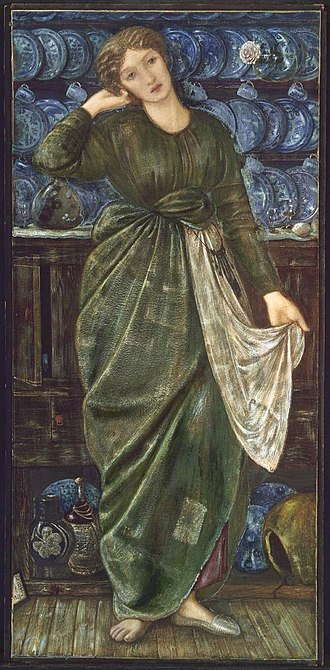 |
| Cinderella: Burne-Jones. |
The story of
Cinderella has (A) the wicked stepmother, who also (B) does not allow her out, even though in theory this would be a way to get rid of her. Cinderella nevertheless manages to escape to the ball (D), disguised so that her sisters cannot recognize her. The escape is only temporary; she is obliged to return each night by the stroke of midnight (E). Cinderella is both entrancingly beautiful and exceptionally patient and even-tempered (C).
The story of
Snow White: (A), her wicked stepmother has a huntsman take the child out to the woods to cut out her lungs and liver. Snow White escapes the huntsman by promising to “run into the forest and never come back” (D). The huntsman substitutes the lungs and liver of a boar, which the queen then cooks and devours (an image of B, devouring love?). This does not work, however, because the queen has a magic mirror that informs her of Snow White's continued existence (E). She then tries to suffocate her with a bodice given as a gift (another image of B, smothering love?), then gives her the gift of a poisoned comb, then the poisoned apple. All Snow White's troubles are caused by her great beauty, which provoke the wicked queen’s envy (C). At her apparent death, the seven dwarfs put her in a glass coffin, like a saint's shrine (F); although they believe her dead, this presumes that her body will be incorruptible, like those of some saints.
The British legend of
King Lear, most famous from Shakespeare, and a traditional image of a family gone wrong, reads like a muted version of the Dymphna story. Cordelia is more beautiful, more moral, and more dutiful than her two sisters (C). King Lear demands that each of his children pay him homage beyond what is due to a father; this may be a toned-down version of Damon's demand for sexual favours (B). When Cordelia, out of moral scruple, refuses, she is disinherited (A). She flees to France (D). Later, when her two sisters prove as dishonest as their father should have expected, she returns to defend him, but is killed in the battle (E). In Geoffrey of Monmouth's version, she survives to overthrow her sisters, but later, as one might expect of a chronic depressive, commits suicide. In either version, however, her death restores Lear to the kingship and the kingdom to rightful order (F).
 |
| Psyche and What's-his-name. |
We might also expect to find the motif in the tale of
Cupid and Psyche, both because it is considered the world's oldest written fairy tale (oral traditions are probably much older), and because the name of its protagonist seems to suggest a psychological meaning: literally, this is the story of Soul. It is also the story of Eros—the Greek for “Cupid.” Since Freud held that Eros was the root of mental illness, here in particular his Oedipus complex ought to appear.
Psyche is exceptionally beautiful—so beautiful that she provokes the envy of Aphrodite (C). Her parents expose her as a young woman on a mountainside, understanding that she is being given as a bride to some monster (A, D). The “monster” turns out to be Cupid (Eros), the son of Aphrodite. He has indeed been sent to make her fall in love with some monster, Aphrodite's revenge, but instead falls in love with her himself. They couple, but he remains disguised. When she discovers his true identity, she is banished (D). To recover the relationship, she is obliged to put herself under Aphrodite's control, to be abused (E), like Cinderella. She is given a series of impossible labours she must perform—the sort of double-binds typical, as R D Lang points out, of a dysfunctional family situation. As a result, she shows all the signs of what we would call depression: twice she tries to kill herself. Nevertheless, eventually, having accomplished her labours with supernatural aid, she is reunited with Cupid. Her influence over her new husband, it is said, ensures that he will no longer torment married men and women with urges to infidelity (F).
 |
| Guan Yin, Chinese, eleventh century. |
For comparison, consider the Chinese story of
Guan Yin, known by various names throughout East Asia as the Bodhisattva of Infinite Compassion. She was born as the daughter of a cruel king who demanded that she marry a man of his choice whom she despised (an element of control, surely; a faint B). She flees to a temple convent (D). Her father's control follows her, however (E); he orders the nuns to give her the hardest work, and to allow her no rest, like Cinderella (A). Nevertheless, her goodness is so great that the animals help her with her chores (C ). Her father then tries to burn down the temple (A), and orders her to be put to death (A). She descends to the underworld, but her influence releases those already there from their suffering (F). Her father then falls ill, and can only be cured by a medicine made from the arm and eye of someone without anger. Guan Yin, hearing this, volunteers her own arm and eye for his benefit (F). She becomes the model of the helper figure, one who has vowed to never rest until she has ended all suffering in the universe.
The story of Gaia, Uranus, and Kronos, the
Greek creation myth: Gaia creates Uranus “to cover her on every side,” then mates with him (B). Uranus then seeks to prevent his children with Gaia from being born (A). Kronos is the cleverest and strongest of Gaia’s and Uranus’s children (C). He castrates Uranus with a sickle in order to escape (D).
Kronos himself then devours each of his children as they emerge from the womb (A). Zeus, later the king of the gods (C) is spirited away to a distant cave by his mother and grandmother (D), and a stone is substituted to trick the father.
The Babylonian creation story, told in the
Enuma Elish: Apsu and Tiamat, the primordial couple, mate and produce children, who are trapped in Tiamat’s womb. Apsu wants to kill them (A). Tiamat warns Ea, the most powerful of her children (C). Ea kills Apsu and becomes king of the gods. Tiamat then takes her son Kingu as her new mate (B). Together they raise an army of monsters to destroy her other children (A), but are defeated by her grandson, Marduk.
 |
| Brahma and daughter-consort Saraswati. Don't try this at home. |
The Hindu creator,
Brahma, chooses his own daughter, Saraswati, as consort, against her will (B). This transgression is why Brahma is not generally worshipped in India. Saraswati is so beautiful that Brahma sprouts four heads to ensure that she is constantly visible to him (C ). Saraswati flees him, first disguised as a cow, then as a mare, then as a succession of different creatures (D). Nevertheless, Brahma always remains in pursuit (E). Trying to rescue Saraswati, Siva is driven mad by Brahma; but Saraswati is able to heal him with a touch (F). She assumes a position in Indian culture similar to that of the Muses in Greece: she is the patroness of the arts and of all knowledge (F).
The story of
Heracles (Hercules), the classic Greek hero myth: Heracles is the illegitimate son of Zeus, making Hera, as his name implies, his step-mother. She, however, hates him as living evidence of her husband's infidelity (A). She first tries to prevent his birth (A), then his birth mother exposes him (A). Like Oedipus, however, or Moses, Heracles is rescued and inadvertently adopted and nursed by Hera, not aware of his identity (A). This parentage leaves him with superhuman strength (C). Later, Hera sends snakes to kill him in his cradle (A).
_-_WGA09570.jpg) |
| Psyche's second labour. |
As an adult, driven mad by Hera, Heracles kills his own children (A). It is to expiate this deed that he is forced to undergo his famous twelve labours. These require him to go to the very end of the earth, to collect the apples of the Hesperides (D). He is also one of the Argonauts who reach the opposite end of the Greek world, Colchis (D). This, however, is not the end of his troubles; Hera is still able to make him go mad (E), so that he kills his best friend. Ultimately, Heracles is credited with freeing Prometheus from his long torment on the Caucasus mountains, and Theseus from Hades (F). His death is an apotheosis, and he is worshipped as an Olympian.
The
Theseus story has the same basic elements. Theseus, the strongest of men (C), is raised apart from his father, the king Aegeus. When he arrives, a young man, in Athens, his father's new wife is Medea, who has already killed all of her own children with Jason (A). She feels similarly toward Theseus, and tries repeatedly to off him (A), first by making him capture the Marathonian Bull, then by giving him poison. Theseus then volunteers to be one of the young sent as tribute each nine years to Crete to be fed to the Minotaur (A, D). He falls in love with Ariadne, princess of Crete, who helps him kill the Minotaur. However, Athena forces him to leave Ariadne behind, a loss they both suffer from for the rest of their days (E). The ship with which he returned to Athens is preserved from that time on by the Athenians as a sacred shrine (F).
Later, Theseus's wife Phaedra falls in love with his son Hippolytus (B). Phaedra falsely accuses Hippolytus of raping her (A) before hanging herself. Theseus then, misled, depending on the version, either kills Hippolytus with his own hands, or curses him, causing his death. Hippolytus becomes the object of a cult, in which young girls about to be married offer up at his grave locks of their hair (F).
 |
| Perseus and Andromeda: Burne-Jones. |
Then there is
Perseus. His father, unable to prevent his birth (A), casts him into the sea in a wooden chest (A, D). He is found and raised by a fisherman. The fisherman's brother falls in love with Perseus's mother Danae, and takes a hate to his prospective step-son (A, E). He sends Perseus off to kill Medusa, an impossible task, a double-bind. The lad nevertheless succeeds, and on his return, comes across Andromeda, left out by her parents a a human sacrifice (A). Perseus is supernaturally strong; Andromeda has provoked the envy of the goddesses with her beauty (C).
In fairness, it should be noted that both Theseus and Perseus can be said in a sense to have killed their fathers, as Freud would expect. Theseus, distracted by grief, forgets to raise a white sail on his returning ship. His father Aegeus, seeing this sign of a failed mission, kills himself in grief before he can learn the truth. And Acrisius, Perseus's birth father, steps into the trajectory of a quoit thrown by his son in a demonstration of the sport, and dies. But both these acts, like those of Oedipus himself, are unintentional on the part of the son, and the fault of the parent, if anyone's. The point, I presume, of the motif is that children really do “kill” their parents in a symbolic sense: they will survive their parents, and their existence is a reminder and a proof that the parent is not immortal. The main point the myths seem to want to make in mentioning this is that the children are completely innocent and cannot be blamed for this. Nor can the parent escape this truth by harming the child.
Let's compare the great Indian hero tale, the
Ramayana. Rama, being an incarnation of Vishnu, excels in all branches of learning and all the martial arts; he is “the perfect man” (C). Although he is the oldest son of King Dasharatha, his stepmother Kaikeyi connives to have him cut from the succession and banished for fourteen years (A, D). During this exile, the demon king Ravana abducts his wife, Sita; he is obliged to travel the length of India, to Sri Lanka, in order to defeat the demon and rescue her. He then returns to his home, Ayodhya, and becomes a king who rules in perfect justice, presiding over a golden age (F). His reign is not happy for him personally, however: the population suspects the purity of Sita, his queen, because of her abduction, and so he is obliged to live apart from her for the remainder of their lives (E). A sad ending to a love story.
 |
| The infant Krishna being carried to safety across the swollen Yamuna River. |
Krishna, the other great Indian hero, is persecuted by his uncle, King Kansa (A), who had killed all his older brothers as they emerged from the womb. To protect the infant, Krishna is smuggled away and given to a family of cowherds to be raised (D). Kansa sends a succession of demons to kill him (A, E), but he defeats them all, demonstrating his superhuman powers (C). He goes on to become the counsellor of Arjuna in the
Bhagavad Gita, stilling his doubts over participation in a fratricidal war (F). The
Bhagavad Gita is also considered the essential stsatement of Hindu faith.
What do you think? Have I made my point? I could go on …
At a minimum, the motif of the bad parent seeking the total control or destruction of his or her children is everywhere in world mythology. I am inclined to believe that this is a conscious and intentional thing, that mythology and fairy tale was and is psychology. It was created and preserved as medicine for souls. But, at a minimum, there is obviously a motif here that has resonated with readers and audiences everywhere and at all times, suggesting a common and deeply affecting experience.
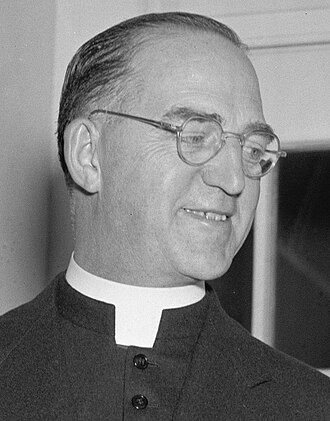















.jpg)



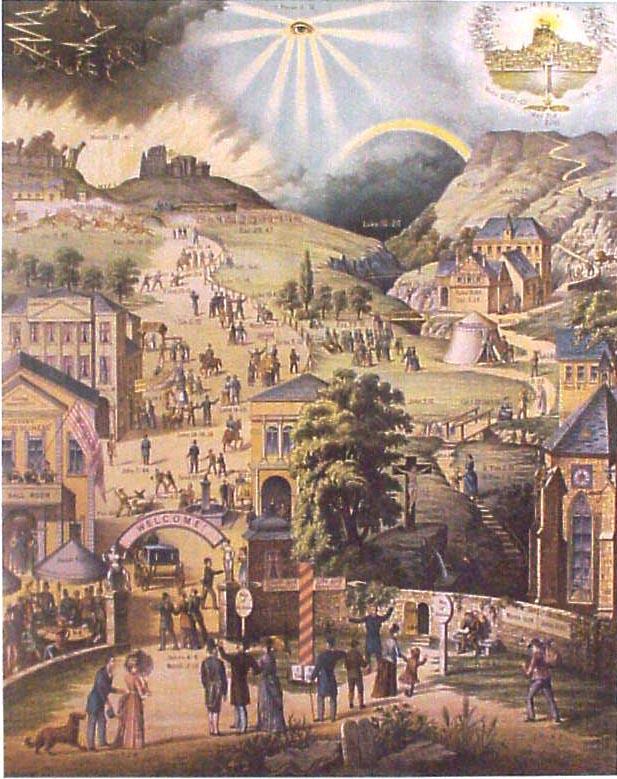










_-_WGA09570.jpg)








.jpg/489px-Francisco_de_Goya%2C_Saturno_devorando_a_su_hijo_(1819-1823).jpg)

